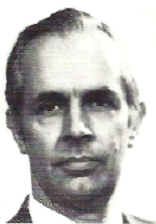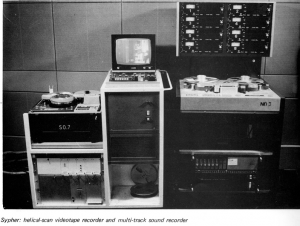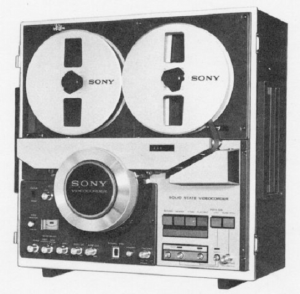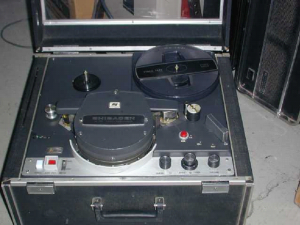Background
SYPHER is “SYnchronised Post-dub Helical-scan and Eight-track Recorders”.
John Eden-Eadon was responsible for progressing the concept and for the operational specification of the system – and gave it that name. The BBC Engineering Monograph number 108 December 1977, section 3 mentions how the name came about.
Pre-SYPHER days
Patrick Heigham
I recall a session down in VTR, for the Christmas panto with Norman Wisdom. There was a lot of video editing (cut and splice) needed, and I had a TR90 deck with the audio, with which I was matching and adjusting the audio edits off a copy tape. TIM for sync later.
Development of SYPHER
John Eden-Eadon

In 1977 John Eden-Eadon was Sound Manager responsible for drama sound in London Television Studios.
He had progressed from Boom Operator to Sound Supervisor, and joined the Sound Management to start Sound Training Courses.
During the previous few years his main interest had been in the development of post-production sound dubbing techniques.>
SYPHER
“…The proposed new system would make use of a multitrack sound recorder (MSR) to accommodate a copy of the edited videotape sound track, the rebalanced and dubbed track and a time-code sync track. Synchronised with the MSR would be a helical-scan videotape recorder (HVTR) to provide a copy of the videotape picture and an identical time-code track. An essential accessory would be a comparator/synchroniser to ensure that Playback and Record functions would produce accurate synchronism of sound and pictures…”
John Eden-Eadon’s article describing the development, outline technical specification and use of SYPHER from “BBC Engineering” number 108 December 1977 is reproduced in full here:
Click on Download PDF to see the PDF in an alternative viewer: this allows you to print or save the complete PDF document, and often makes the document easier to read.
To return to this page, use your browser’s Go Back One Page button.
Operational Use of SYPHER
Alan Stokes, Martin Eccles
For those not familiar, SYPHER was developed in the days of 2″ quad VTR when sound post-production work was possible but not convenient. Before SYPHER, the programme was edited and then the tape was played back via a suitable sound suite and recorded on a second 2″ VTR. It was possible to stop and pick-up but this was avoided if possible. In essence, the sound dub was recorded ‘as live’ It was expensive (2 x 2″ Quad VTs plus operators). After final review the sound from the copied tape was transferred back, sound only, to the master tape. This way, there were no further generations of pictures which, a VTR person might confirm, became obvious after more than 2 or 3 iterations.
When timecode was developed, off-line sound dubbing became possible. Timecode uniquely identified each frame of the master VTR. Synchronisers (not video for picture mixing) were then used to lock a multi-track audio recorder to a low quality helical-scan VTR (initially reel-to-reel but later a U-Matic cassette format). This way, the use of 2″ machines was much reduced.
To get some idea of the work-flow, some while ago I uploaded to YouTube a short programme which describes the process. This is the 1980 production of “The Sound of Sypher”. It has demonstrations of all three Sypher suites – Sypher One, Sypher Two and Limited Sypher.
It can be seen at:
Barry Bonner
I never realised how clever we were!
I once (only once? surely not!) upset a sound manager by referring to SYPHER as So You Probably Haven’t Even Recorded!
Peter Cook
Apocryphally: Save Your Programmes HERe.
John Howell
To quote the Production Guide published by H.Tel. Sound, and written by John Eden-Eadon:
” SYPHER stands for Synchronised Post-dub, Helical scan and Eight-track Recorder”
SYPHER is also a carpentry term meaning “to lap (a chamfered edge of one plank over that of another) in order to form a flush surface” which pretty much describes what we could do to the sound track when Sypher dubbing.
I thought possibly the name was coined by John Eden-Eadon out of his knowledge of carpentry.
John Eden-Eadon
I did coin the abbreviation “SYPHER”. I searched for many hours to find a title that included significant technical detail used in a new and complex system. I wanted a title that anyone in the making of television programmes would recognise as a process and would be used as shorthand for the system. I think it worked.
I know why John thought about the connection to carpentry, however I found that “sypher” was a plumbing term meaning ‘to join together using overlaps’ and equally descriptive. I think the word served its purpose. That was so many years ago, 1972.
Mike Giles
I think I recall Des Browning claiming to have burnt much midnight oil in determining how SYPHER would work.
Dave Plowman
I assumed the name was devised by Johnny Eden.
Incidentally, Thames TV at Teddington had their own in house system before SYPHER. Called Medway, using a low grade VTR and multi-track. The main difference was the in-house code – before timecode – which had a 4 minute rather than 24 hour window.
Chris Booth
The true story.
The late Don Kershaw left us all his notes following his death in May 2008 – among them was the book he never finished chronicling the development of videotape. Here is the story of SYPHER.
Equipment for this operation enabled a major breakthrough in handling the sound associated with video tape edited television productions. Video Tape Editors did a wonderful job of editing the sound, but quite often, additional work was required to “sweeten” the sound to satisfy the production requirement in a similar way to sound activities in Film Production.
We needed equipment for an operation which copied the edited video and audio using a cheap Helical Scan recorder for the video and a professional quality multi track recorder for the audio. Time code would be recorded on both, and the two tapes taken to a specialised dubbing suite where the two tapes would be played back in synchronism using the time code. Using the spare tracks on the multitrack recorder, the sound would be modified and re-recorded onto the final track.
Finally the audio tape would be synchronised to the edited video tape and copied to its audio track.
A Sony U-Matic recorder with the time code “Burnt” into the picture was used for the video, and a Studer Eight Track A 80 recorder was used for the audio. Unfortunately a suitable synchroniser was not available commercially and Ray Taylor (Designs Department) designed one for us. We were adamant that the system should be automatic with time offsets applied when required.
The sound supervisor controlled the Sony U-Matic and the synchroniser needed to control the A 80 such that it “chased” the U-Matic through all its transport modes, spooling back and forth and in playback completely automatically. The same rules applied to the operations involved in recording the tapes and re-recording back the audio at the VTR end of the operation.
The whole project involved much innovation and was a huge success.
Before the synchroniser was complete we took a gamble and recorded a number of big band concerts using an A80 for multitrack audio. We crossed our fingers that the synchroniser would be finished in time to put the completed sound on video tape.
Louis Barfe
This would have been “Big Bands at the Dorchester”, produced by Stanley Dorfman. Stewart Morris was head of variety at the time and years later he told me that they’d recorded the audio on multi-track too, and wondered whether the tapes still existed. On each show of that series, there are two credits for sound – Chris Holcombe and John Timperley. I’ve always assumed that Timperley, who was a recording studio man rather than television, working at Olympic, Chappell’s and then Angel, was there to take care of the multi-track aspect.
Dave Plowman, Philip Tyler, Bernie Newnham, John Howell
I thought Sypher pre-dated U-Matic and started out with a real to reel machine? It was a Shibaden, see picture.
(Click on the picture below to see larger version:
use your Browser’s BACK button to return to this page)

It was a Sony colour helical scan in Sypher itself and Shibadens in the edit rooms.
Dave Plowman
That’s what I remembered. I’m not sure the Shibadens had the ability to record/read LTC.
The U-Matics we had at Teddington were modified with a wideband amp for the code track (one of the stereo pair) to allow it to read when spooling. Not that they spooled that fast.
Barry Bonner, Derek Martin
Sony Helical Scan:
(Click on the picture below to see larger version:
use your Browser’s BACK button to return to this page)

We originally had a Shibaden which regularly bootlaced the tape if you went from fast forward or reverse to stop. Cure…flatten the tape as best as you could and stick it together with a bit of 1/4 inch splicing tape vertically! Did it many times! Remember the Shib-Shed – the corner of VT where 2″ was transferred to 1″ helical.
(Click on the picture below to see larger version:
use your Browser’s BACK button to return to this page)

The Shibaden was used for our prep day prior to the dub, it was a monochrome machine with poor transport controls hence snapping and bootlacing the very thin tape. The time code was burnt in on the bottom of frame thus covering up any switches on Dr Who’s Tardis making it guesswork to log the associated sound effect. The machine we had in the SYPHER suite was colour and, eventually, we had control of where to put the time code.
Alan Stokes
A Sony 1″ colour (not C-format) reel-to-reel was used for the actual dub.. The Shibaden was for prep and monochrome. Not the nicest machine but it served its purpose.
Chris Booth
The Shibadens were very useful in the 2 inch edit suites. The EIAJ Colour version was excellent at locating cuts – and time code!




